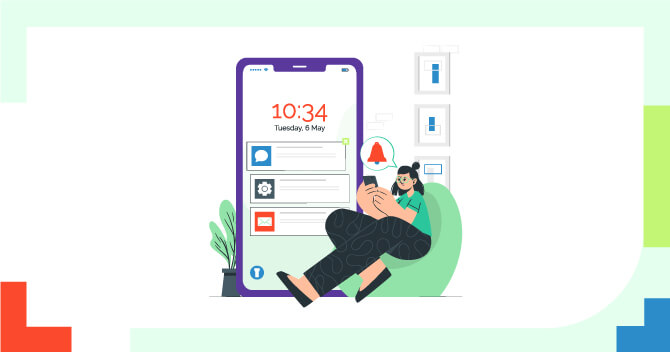October 4, 2023

For a long time, brands have been told that using push notifications will help them stand out from the other apps on a user’s phone screen. They have been lauded as offering advertisers a novel technique to boost customer retention and encourage re-engagement. Push notifications seem to be the golden ticket marketers have been waiting for as smartphone usage keeps growing at an unheard-of rate.
So why haven’t more people taken that approach?
The effectiveness of push alerts and push marketing in general has been hotly contested. What is the efficiency of push notifications? Are they actually valuable to people?
The following is the defence offered against push notifications:
- The user will be interrupted and diverted from whatever they are doing by push alerts.
- Users that desire push alerts will enable them on their own, although they are obtrusive.
- Users may stop using an app altogether instead of returning if they anticipate a quick response.
Push marketing may at first seem intrusive and unwanted, but the statistics paint a totally different picture.
The survey found that 61% of new app users who received push alerts started using the app during the first month, which is more than double the 28% of installers who did not. Push notification enablers launched eCommerce apps 278% more often than push notification disablers.
In reality, the introduction of push notifications has significantly increased Facebook’s user traffic.
Push notifications may improve app launches, engagement, and retention when used properly. However, if you implement them incorrectly, as our study suggests, you will see a rise in app uninstalls and opt-outs, as well as a very negative connotation with your brand.
How can you as a marketer analyze the push notification phenomenon? Let’s learn together.
Promote to humans instead of gadgets
Push messages that are relevant and tailored are desired. They are adept at detecting generic, broadcast messages that are a clear component of a re-engagement strategy. Receiving pointless push messages is a frustrating distraction, and receiving too many of them may cause the consumer to completely cease making purchases from you.
However, personalizing push notifications can increase open rates by 4 times. Serving recommendations based on the things the user has demonstrated an affinity for in their browsing and purchasing history is one very successful and unique method of personalized push notifications.
Location-based push alerts that are timely
The last thing you want, if you’re like most people, is to wake up at 2AM to the buzz of a push notification from an eCommerce app. There are numerous accounts of push notifications that arrived at the wrong moment. 63 percent of marketers absolutely err when it comes to push marketing campaigns’ messaging, timing, and frequency.
Typically, this takes place in two ways:
- When push notifications are sent at different times than when consumers access and interact with them, the messaging is frequently out-of-date.
- While most users are sleeping at midnight, marketers are sending push notifications in order to target North American peak periods rather than local advertising.
When should the message be delivered?
Start by setting up conditions to base the push on the user’s most recent or previous active period. Marketers can set up settings to deliver the push message around 8 PM, when the user is most likely to make a purchase, for instance, if the user typically launches the app at 6 PM but makes purchases around 8 PM.
Geo-targeting users and sending messages in accordance with each user’s local time zone is the solution to the location issue. Marketers can even modify particular promotional messages based on the user’s location and the weather.
It’s crucial to note that location-based notifications are not only applicable to online purchases; businesses with physical stores can promote in-person visits by sending an enticing push message to nearby users.
Utilize customized push notifications to lower cart abandonment
While sending cart abandonment emails is a crucial strategy for recovering sales from abandoned carts, open rates for push notifications are 50% higher than for email, and click rates can be up to twice as high. This is because customers abandon their carts for a variety of reasons, including high shipping costs, more affordable alternatives, window shopping, etc.
By sending reminders to a group of visitors who left your mobile website or app after starting the checkout process, you may proactively enhance mobile conversions.
Use time-limited offers to get offline users back into the app
According to Responsys data, 50% of customers allow push alerts to receive unique discounts or promotions. Discounts that are only available for a short period of time can be a very powerful approach to entice people who have abandoned your app.
Like always, it must make sense for your company to give a discount. We advise starting with latent users rather than simply sending discounts to everyone.
Conclusion
One of the best ways for eCommerce marketers to encourage re-engagement with mobile apps and increase retention is through push notifications. While irrelevant and spammy push messages may drive clients away, well timed and personalized push notifications will thrill them.
Push notifications, like all 1:1 message, must be tested and optimized because they represent a continuing interaction with your clients. Always keep an eye on your customer data to learn how each push message affects various user groups and how push messaging fits into your entire marketing strategy.
- So why haven't more people taken that approach?
- Promote to humans instead of gadgets
- Location-based push alerts that are timely
- Typically, this takes place in two ways:
- When should the message be delivered?
- Utilize customized push notifications to lower cart abandonment
- Use time-limited offers to get offline users back into the app
- Conclusion

